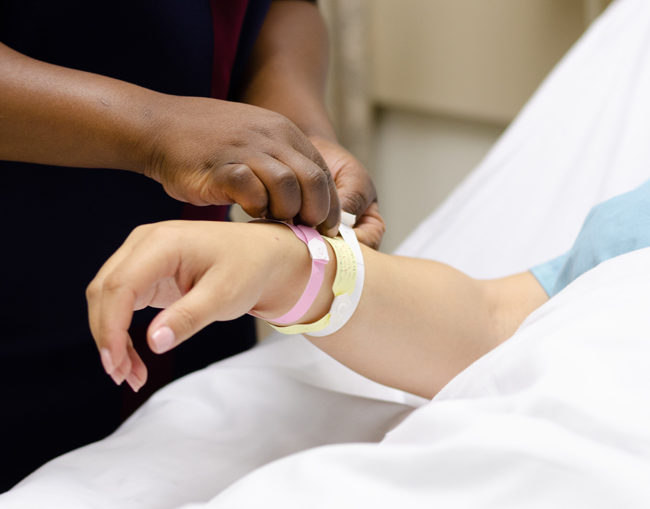Why Individual Recognition Bands Are Essential for each Healthcare Facility
In the complicated landscape of healthcare, person recognition bands work as a fundamental component in protecting person security and minimizing clinical mistakes. These bands provide important information that not only assists in exact identification however additionally enhances interaction among health care service providers. As institutions aim to fulfill regulatory compliance and improve overall process effectiveness, the role of identification bands comes to be significantly substantial. The ramifications of their use prolong past simple compliance-- what are the prospective consequences of overlooking this necessary technique? Discovering this concern discloses a much deeper understanding of individual security and high quality care.
Averting Medical Errors
In the world of health care, stopping clinical errors is critical to ensuring person safety and security and top quality of care. Among the most critical aspects in mitigating such mistakes is the accurate recognition of people. Misidentification can result in unsuitable treatments, medicine errors, and even surgical errors, all of which can have terrible repercussions for individuals and health care service providers alike.
Person recognition bands act as an essential device in this precautionary approach. These bands typically have important information, such as the person's name, date of birth, and special identification number, enabling medical care experts to verify the person's identification promptly and precisely prior to carrying out any treatment. Making certain that these bands are appropriately used and constantly made use of throughout all medical care setups is important.
In addition, the application of electronic health documents (EHR) can boost the efficiency of person recognition bands by integrating them with digital systems that flag prospective inconsistencies. Routine training and adherence to procedures pertaining to making use of individual identification bands can substantially reduce the possibility of errors. In recap, robust person identification practices are necessary for securing and decreasing medical errors individual well-being within health care atmospheres.
Enhancing Client Safety
Individual safety and security is a multifaceted idea that incorporates various techniques and techniques created to shield people from injury throughout their health care experience. One vital part in improving individual safety and security is the application of individual identification bands. These bands act as a crucial device for ensuring that healthcare carriers can accurately recognize clients, hence reducing the risk of misidentification.
The existence of patient identification bands substantially minimizes the opportunities of administering incorrect medications, performing unintended procedures, or falling short to identify allergies. By fastening an one-of-a-kind identifier to every person, medical care centers produce a dependable system that promotes accountability and alertness amongst medical staff. This proactive approach not just enhances the security of people yet also instills a sense of trust in the health care system.
Additionally, individual identification bands add to a standardized method that can be conveniently incorporated right into digital wellness documents. Patient Identification Band. This combination ensures that crucial person information is easily available, more strengthening precaution. Ultimately, the effective use of recognition bands is an essential practice that underpins a society of safety, intending to safeguard patients and boost overall healthcare outcomes
Improving Interaction
Reliable communication is crucial in the medical care setup, as it directly impacts person safety and care high quality. Patient recognition bands act as an essential device for improving communication amongst doctor. By plainly presenting vital person information such as name, date of birth, and clinical document number, these bands help with precise identification, lowering the risk of mistakes in therapy and drug management.
Furthermore, person recognition bands cultivate a culture of accountability and verification within healthcare teams. When all employee are equipped with prompt accessibility to reputable person identification, the probability of miscommunication reduces significantly. redirected here As an example, during handoffs between shifts or interdisciplinary assessments, the existence of identification bands ensures that every person included is on the same page concerning individual identification and medical history, therefore lessening misunderstandings.
Furthermore, these bands can incorporate with digital health and wellness records (EHR), permitting for smooth communication of individual information across numerous systems. This connectivity not just boosts the performance of information sharing but likewise sustains a more collaborated method to patient care. Eventually, the fostering of patient recognition bands is essential for enhancing interaction, therefore adding to better health and wellness results and guaranteeing that patients get the greatest requirement of treatment.

Streamlining Process
The application of patient identification bands significantly contributes to enhancing operations within medical care environments. By supplying clear and immediate recognition of clients, these bands decrease the time healthcare experts invest validating individual information. This effectiveness lessens the capacity for mistakes, enabling personnel to concentrate on direct person treatment instead than administrative jobs.
With standard recognition procedures, medical care groups can quickly access crucial individual data, consisting of case history, allergies, and therapy strategies. This rapid accessibility enhances decision-making and permits for timely treatments, ultimately improving client end results. The usage of identification bands facilitates much better sychronisation among multidisciplinary groups, guaranteeing that all members have the right information at their fingertips.

On top of that, individual identification bands can be integrated with digital wellness document (EHR) systems, further maximizing workflow. By scanning a band, medical care suppliers can quickly share and upgrade details, thus lowering redundancy and improving paperwork initiatives. This assimilation aids maintain a continuous flow of details, which is crucial in dynamic health care setups.
Ensuring Regulatory Conformity
In today's health care landscape, guaranteeing regulative conformity is extremely important for keeping patient safety and business stability. Patient identification bands play an important function in meeting numerous governing criteria, such as those look at this site established forth by the Joint Payment and the Centers for Medicare & Medicaid Solutions (CMS) These companies emphasize the requirement of precise client identification to lessen medical errors and improve the high quality of care.

Applying standard client identification bands aids medical care facilities abide by regulations that call for exact client identification at every stage of care. This consists of medicine administration, procedures, and blood transfusions. Non-compliance can bring about major repercussions, consisting of fines, loss of certification, and, most importantly, threatening individual safety.
In addition, making use of modern technology, such as barcoding and RFID systems incorporated with client recognition bands, can additionally enhance conformity initiatives by making sure that the right patient gets the best treatment at the ideal time. By focusing on the implementation of robust person identification systems, medical you could look here care facilities not just comply with governing criteria but additionally promote a culture of safety and security and responsibility, eventually improving individual end results and rely on the medical care system.

Conclusion
In final thought, individual identification bands serve as a fundamental element in medical care facilities, substantially adding to the prevention of medical mistakes and the enhancement of client safety and security. Eventually, the execution of patient identification bands is essential for promoting a safer health care setting and improving general individual end results.
In the complex landscape of healthcare, patient identification bands serve as a fundamental aspect in guarding person safety and reducing clinical errors. These bands commonly include vital info, such as the person's name, date of birth, and unique identification number, allowing healthcare professionals to verify the client's identification promptly and properly prior to carrying out any kind of treatment.Implementing standardized person recognition bands helps healthcare facilities comply with guidelines that call for exact individual recognition at every stage of care.In conclusion, patient recognition bands serve as an essential element in health care facilities, dramatically adding to the prevention of medical errors and the improvement of person safety and security - Patient Identification Band. Ultimately, the application of person recognition bands is crucial for cultivating a much safer healthcare environment and boosting general client results